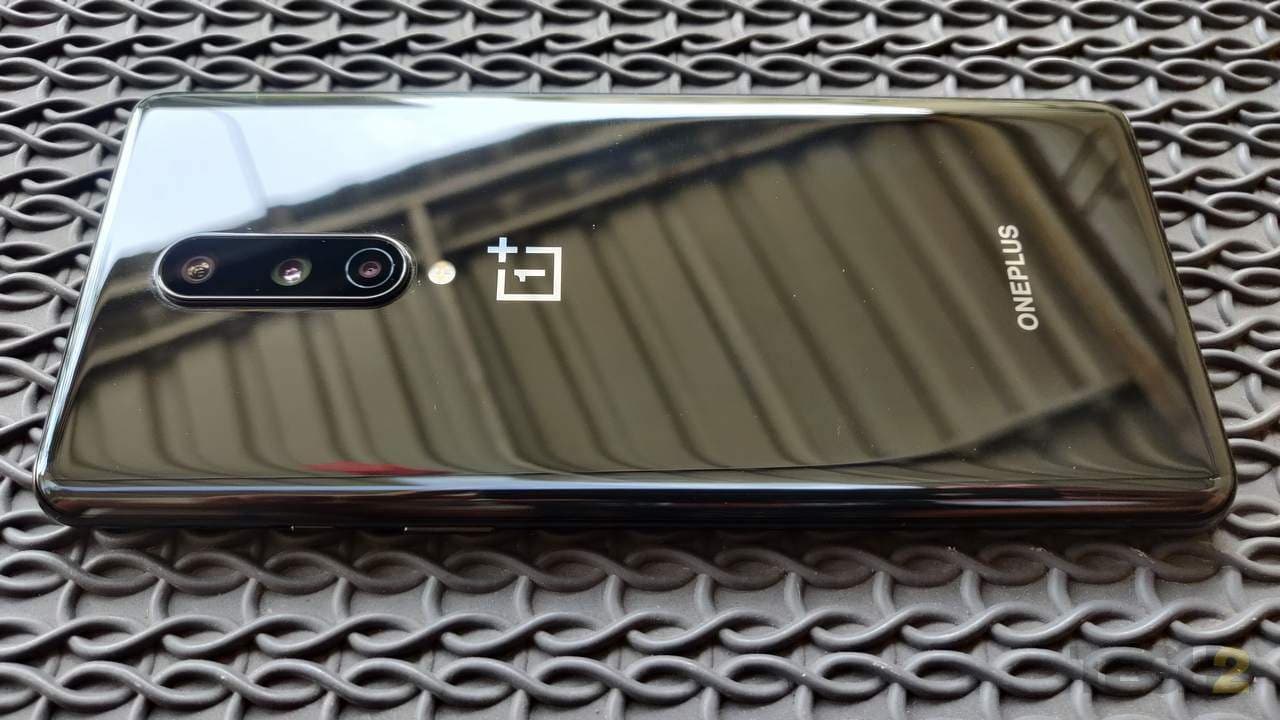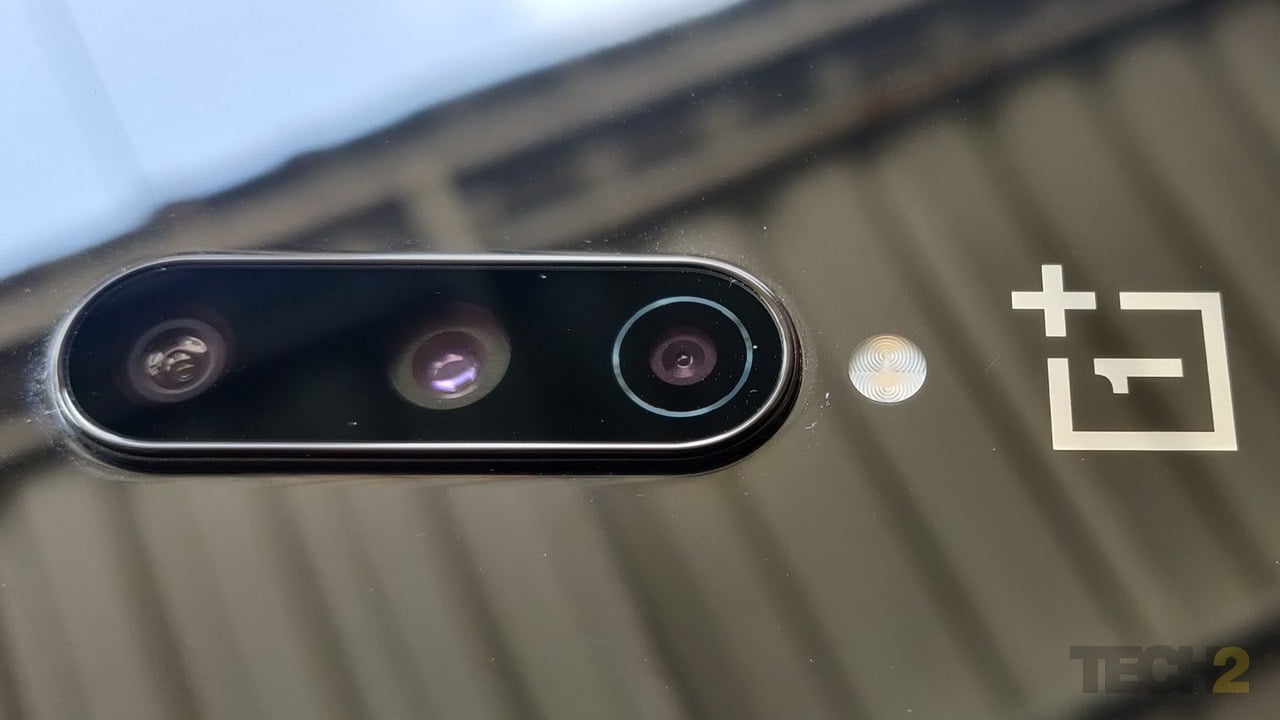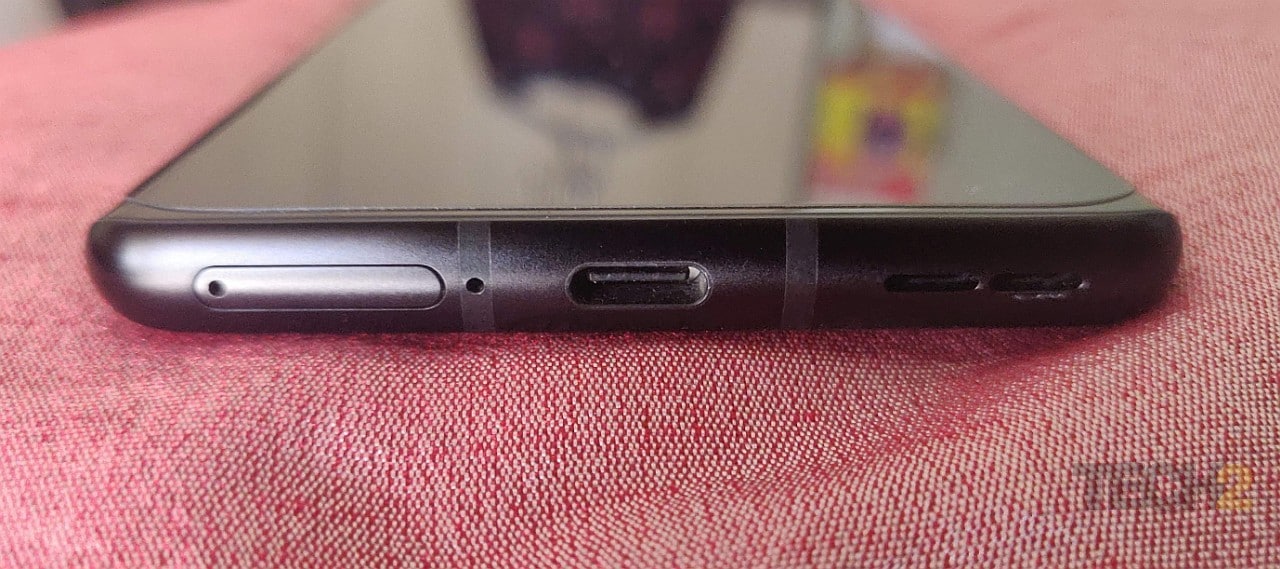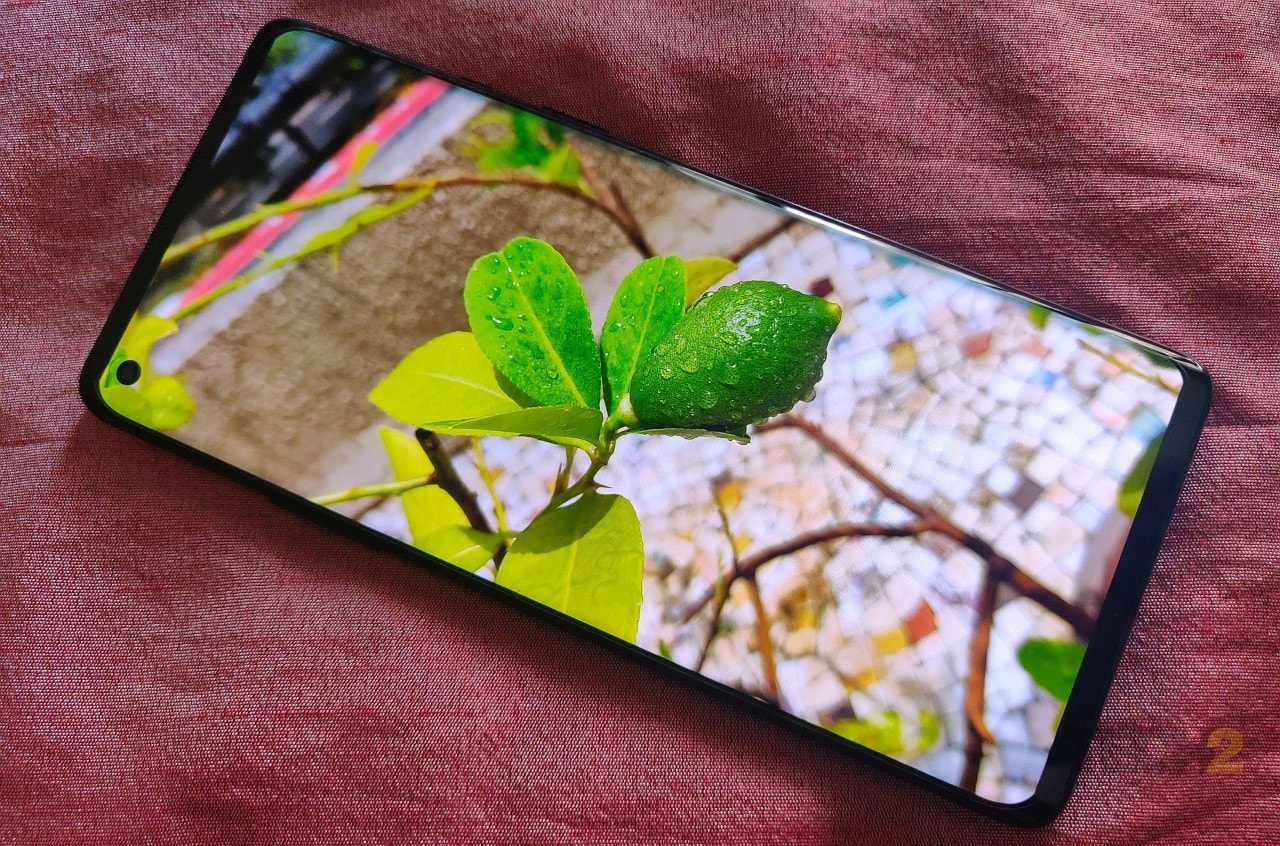Every OnePlus phone launch creates a massive buzz. But not every new handset offers significant upgrades over its predecessors.
To be brutally honest, going by the company’s track record, every third release seems to hit the bullseye, while the other two are just evolutionary upgrades that OnePlus churns out every six months. The OnePlus 7T was one phone that seemed like a major upgrade over the OnePlus 7 and the 6T and was always going to be a tough act to follow in just two quarters.

The curved glass design looks very elegant, and the phone feels surprisingly compact despite its big 6.55-inch display.
OnePlus 8 vs OnePlus 8 Pro: What’s missing?
Before we proceed with the review, let’s get one thing out of the way ― what’s missing on the OnePlus 8 as compared to its Pro variant. At the time of its launch, the OnePlus 7T was such a well-rounded device that there wasn’t any compelling reason for many to buy the more expensive 7T Pro. This time around, the company seems to have a clear mandate ― to make the Pro variant look significantly better, even if that happens at the cost of the non-Pro model.
The OnePlus 8 Pro has a handful of new features that have been excluded from the OnePlus 8. Some of the key ones include a 10-bit display with support for over a billion colours and 120 Hz refresh rate, faster DDR5 RAM, wireless charging and IP68 certified dust and water resistance. The Pro variant also gets a far superior camera setup with a newer 48MP Sony sensor, 3X Optical zoom, and a higher resolution ultra-wide camera with PDAF (phase-detect autofocus). All this comes at a premium of Rs 10,000 over the OnePlus 8, with similar RAM and storage.
The reason I wanted to get this out of the way early is because from here on, for the better part of the review, I want to analyse the OnePlus 8 for what it brings to the table and not what’s missing compared to the 8 Pro. So, let’s see what we get.
OnePlus 8 Design: There’s something very nice about it
Though the OnePlus 8 design doesn’t feel striking or unique at first glance, the phone feels very good in hand, though a touch slippery. There are a few subtle changes from previous generations, and they are very effective. The curved glass design looks very elegant, and the phone feels surprisingly compact despite its big 6.55-inch display. Though the OnePlus 7T has a similar sized screen, the company has managed to shave off a few millimetres on each side, making the phone look noticeably smaller than it actually is. It weighs 10 grams less than the 7T too, at 180 grams, despite its Aluminium frame and glass back.
The phone feels great to hold, but it's hard to reach the top of the screen with your thumb unless you have huge hands. This is down to its tall design. To compensate, the in-display fingerprint scanner is placed a little higher than usual, making it easier to access. The scanner is highly responsive too and worked perfectly. Like most of its competitors, OnePlus has done away with the notch and opted for a punch-hole selfie camera near the top left corner of the screen. While I have no issues with punch-hole cameras, I do have a problem with its placement for practical purposes. The screen space on the left of the camera is wasted, and the notifications start from the right of the camera, a good centimetre away from the left edge. Thus, you lose more screen real estate over a centrally located selfie camera with a punch-hole, or even a drop notch.

The camera module is quite similar to that of the OnePlus 7, with one extra camera.
The display as well as the back of the phone are protected by 3D Corning Gorilla Glass, making the OnePlus 8 scratch resistant. However, the Onyx Black variant that we got for review does attract a fair share of smudges and fingerprints, especially at the back. This may not be as conspicuous a problem in other colour variants of this phone. Speaking of the back, OnePlus has done away with the Motorola-inspired circular disc for cameras that was present in the 7T and gone back to the vertically aligned camera module at the top centre. It is quite similar to that of the OnePlus 7, with one extra camera.
The SIM tray is present along the bottom edge of the phone and it can accommodate up to two nano-SIMs. The OnePlus 8 is a 5G phone, for whenever the service is available in India. Till then, you can have two 4G SIMs in there. Giving the SIM tray company are a USB Type-C port and the phone speaker. The volume rocker is placed along the left edge, while the power button can be found on the right edge along with the alert slider. Reaching the volume up button is a bit of a stretch (literally), and I wish they had placed it a little lower. No issues with the placement of the power button though.

Giving the SIM tray company are a USB Type-C port and the phone speaker.
OnePlus 8 Key specifications
- Qualcomm Snapdragon 865 SoC: 1 x 2.84 GHz Kryo 585 core + 3 x 2.42 GHz Kryo 585 cores + 4 x 1.8 GHz Kryo 585 cores
- Adreno 650 GPU
- 6 GB or 8 GB RAM options
- 128 GB or 256 GB UFS 3.0 internal storage
- 6.55-inch Full HD+ (2400 x 1080) Fluid AMOLED display with 90 Hz refresh rate and 3D Corning Gorilla Glass
- Cameras: 48MP with PDAF and OIS (main) + 16MP (ultra-wide) + 2MP (macro); 16MP (wide) selfie camera
- 4300 mAh battery with bundled 30W fast charger
- Android 10 with OxygenOS 10
- 5G compliant; Bluetooth 5.1; Dual band WiFi a/b/g/n/ac/ax
OnePlus 8 Price in India
Rs 41,999 for 6 GB Ram with 128 GB internal storage
Rs 44,999 for 8 GB Ram with 128 GB internal storage
Rs 49,999 for 12 GB Ram with 256 GB internal storage
OnePlus 8 Display: A sharp screen that looks even better in reality than on paper
The OnePlus 8 has a 6.55-inch Fluid AMOLED display with a resolution of 2400 x 1080 pixels and 90 Hz refresh rate. On paper, the specs look similar to that of the 7T, but in reality, it looks even sharper. Despite not supporting a billion colours or 120 Hz refresh rate like the 8 Pro screen, you don’t feel like you’re missing anything. The display is extremely vibrant and smooth.

The OnePlus 8 has a 6.55-inch Fluid AMOLED display with a resolution of 2400 x 1080 pixels and 90 Hz refresh rate.
The black levels and contrast are excellent ― as it should be with an AMOLED screen ― and colours pop in ‘Vivid’ mode without going over the top. If you don’t like your colours boosted and want them to be more accurate, there’s a ‘Natural’ mode too. The phone also offers you a few manual calibration options in case you’re interested. The screen supports HDR10+ and compatible HDR content from OTT platforms looks noticeably better on this device.
The 90 Hz refresh rate makes things flicker-free while scrolling in compatible apps. You get an option to switch to 60 Hz to save some battery, but personally I preferred to leave it at 90. This isn’t an always-on display, but one can see basic information like time, date, battery status and a few notifications by simply lifting the phone or tapping the screen. As I mentioned earlier, the screen is protected by a layer of 3D Corning Gorilla Glass. The curved edges of the display add a bit of style without hindering any functionality.
OnePlus 8 Performance: As powerful as they come
The OnePlus 8 is powered by Qualcomm’s current flagship Snapdragon 865 SoC and our test unit had 12 GB RAM to go with it. The performance of this device is top notch. With that kind of processing muscle at its disposal, there was absolutely no lag in day-to-day operations, or in any of the popular apps, or even when switching between multiple apps. In performance benchmarks, it posted some unprecedented scores.
In Geekbench 5, it recorded a Single-core score of 919 which was at par with the iQOO 3 (920 points) and 3% higher than Xiaomi’s Mi 10 (893 points) ― both with Snapdragon 865 chips. The Multi-core score stood at 3356, the highest we have seen in Android phones. The iQOO 3 and Mi 10 managed 3315 and 3173 in the same test. In PC Mark Work 2.0, the three phones scored 10847 (OnePlus 8), 10497 (iQOO 3) and 10838 (Mi 10). The Xiaomi handset finally manages to close the performance gap in this benchmark.
In the 3DMark Sling Shot Extreme - Vulkan benchmark, the Adreno 650 GPU used in the OnePlus 8 scored a record-breaking 6719, as opposed to 6632 and 6103 on the iQOO 3 and Mi 10 respectively. The iQOO benchmark scores are close to that of the OnePlus 8, but the Xiaomi noticeably falls behind in this race. To check the performance boost with respect to its predecessor, we compared the OnePlus 8’s scores to the results of the OnePlus 7T (powered by a Snapdragon 855+) in the above benchmarks and found that there was a noticeable jump in most benchmarks. While there’s just a meagre 3 percent increase in PC Mark score, there’s a good 17 to 20 percent jump in Geekbench performance, and upwards of 23 percent in 3D Mark. We must give Qualcomm its due here for adding some significant muscle to the 865 over the 855+.
These are all synthetic benchmarks, and despite who gets bragging rights courtesy of the numbers above, all the phones in the comparison are extremely powerful, and among the fastest in the market today. The gaming performance of this phone was excellent too; no surprises here. PUBG Mobile as well as Asphalt 9 worked flawlessly at the highest graphics settings. The phone didn’t heat up much either, after 30 minutes of gaming. The dual stereo speakers (earpiece and the speakers at the bottom) manage to produce surprisingly good quality output with a decent stereo effect.
Speaking of audio, the OnePlus 8 also supports Dolby Atmos, and while the surround sound effect isn’t that obvious on the phone speakers, it does provide virtual surround and other sound enhancements for most earphones. The phone also supports AptX, AptX HD and LDAC for better throughput over Bluetooth on earphones that support those codecs. The call quality is also good enough, and there is nothing to complain about in that department.
OnePlus 8 Battery performance: Good battery life, improved fast charging
OnePlus has finally gone past the 4000 mAh mark on its non-Pro models. The OnePlus 8 has a large 4300 mAh battery, despite its 8 mm thickness. It easily manages to last 30 hours, up to a day and a half of normal usage, that includes generous use of messaging and social media apps, browsing, a decent amount of calling and clicking a few photos, an hour of watching videos and a half hour of gaming. That is quite an impressive battery life, given the powerful Snapdragon 865 processor and 90 Hz display (which I didn’t drop to 60 Hz at any time).
OnePlus has been at the forefront of fast charging and the case is no different here. The company bundles a 30W Warp charger that charges the phone from 0 to 50 percent in under 25 minutes, and fully in about 65 minutes. Those are impressive numbers again.
OnePlus 8 Camera performance: A step back as compared to the OnePlus 7T
Before we move on to the performance, I would like to shed light on something I touched upon in my initial impressions too ― the choice of rear cameras on the OnePlus 8. OnePlus got their rear camera combination right in the 7T, offering users the flexibility of a 48MP primary camera with PDAF and OIS (optical image stabilisation), 16MP ultra-wide camera with autofocus, and a 12MP telephoto camera for 2X optical zoom. All that the company had to do was not tinker with the combination. Unfortunately, they did.
The OnePlus 8 has a similar 48MP primary camera with OIS and PDAF, but the 16MP ultrawide camera lacks autofocus. Even worse, the 12MP telephoto camera has been replaced by a paltry 2MP macro camera. So, not only does the phone lose optical zoom functionality, but the 2MP camera sticks out like a sore thumb on a flagship phone. The OnePlus 7T has a macro mode despite not having a dedicated macro camera, and that does a much better job than the specialist here.

Moving on to the performance, the primary camera captures some crisp
shots in bright to average lighting with good dynamic range, especially
with auto HDR (UltraShot HDR) on. Colours feel slightly saturated ― as
is the case with most OnePlus phones ― but not many would complain.
Captured images look sharp, with a good amount of detail. The ultrawide
camera provides you a 116-degree field of view and gives you more than
decent output. The images feel a little less sharp, but the colours look
almost as good as that of the main camera. Its overall performance in
good lighting is a lot better than the ultrawide cameras you get on most
phones around Rs 30,000. But then, this is a much more expensive phone,
and one expects it to be a lot better.
The ‘Portrait’ mode works very well on the OnePlus 8, with good foreground and background separation. I don’t remember seeing an option to manually adjust the level of blur, but the camera does a fair job on its own and I didn’t miss that option. The images come out pretty good, be it human subjects or other objects. Occasionally, I noticed that the camera tends to struggle a bit when focusing on light coloured objects, especially white. The focusing issues weren’t limited to portrait mode, and kept cropping up on and off in almost every mode and type of lighting. At times, it felt like the camera had a mind of its own when trying to focus on an object. I figure it’s a software issue and an update should be able to fix it.
All is generally well with the camera department when the light is good, but as soon as it starts to drop, so does the quality of captured images. Low-light photography isn’t a strong point of the OnePlus 8. The main camera still does a decent job in low light conditions, as compared to the ultrawide camera. It tends to gain a lot and makes images brighter even when not using the ‘Nightscape’ mode. Occasionally, normal shots appear even brighter than those captured in ‘Nightscape’, but there is too much noise and loss of detail. With ‘Nightscape’ mode on, the images look sharper and display a lot less noise, but they tend to go soft near the edges. Your hands need to stay steady and give it a couple of seconds to capture and process the image. Mind you, the images look perfectly usable for sharing on social media, but it is only fair to expect better from a phone priced between 45K to 50K.
There is no optical zoom on the OnePlus 8. You do get a 2X zoom toggle, but that’s digital zoom. Again, the images come out more than decent, but not as good as the ones the 7T’s 2X optical zoom can manage. The 2MP macro camera does what a 2MP camera can. The captured images are average at best, and at par with the 2MP macro cameras on phones priced around 15K. I still don’t know what they were thinking, including this camera on such a premium phone.
Like the rear cameras, the 16MP front camera is quite good when your face is well-lit. The captured selfies are sharp, and skin tone looks natural. However, avoid taking portrait shots with it; they can be hit-or-miss. There is one simple, but really cool thing about the selfie camera, and I wonder why other brands haven’t thought of it yet. When you switch to the selfie camera, you get a white glow around it so that you know exactly where the camera is. Otherwise, it is hard to spot in the dark borders of the camera app. Thanks to the white ring, people in the selfie will know where to look.
The rear cameras on the OnePlus 8 can record videos in 1080p and 4K resolution at 30 and 60 fps, and slow motion 1080p and 720p videos at 240 and 480 fps respectively. Captured 4K footage looks sharp and stabilised, courtesy of EIS (electronic image stabilisation). 1080p videos shot on the main camera look quite sharp too, with good colours. There’s also a 4K Cine mode, which basically lets you shoot 4K videos with 21:9 aspect ratio.
OxygenOS and user interface: Arguably the best in Android universe
The OnePlus 8 runs Android 10 out of the box, with OxygenOS 10 on top; OxygenOS 10.5.8 to be exact, with May 2020 security patch at the time of testing. I have said this in the past and I have no qualms saying it again, that this is the best Android UI around, and probably the best feature of OnePlus phones. It is clean, stutter-free, free of ads and bloatware, and adds a handful of useful features without deviating too far from stock Android UI.
If you have used a OnePlus device in the past, you know what I am talking about. If not, you need to experience it yourself. I can go on and on about it but it’s best I leave it for a separate article. Here, it would suffice to say that OxygenOS includes most of the stuff you would need, without burdening you with unnecessary apps and addons. And given the company’s impressive track record when it comes to software updates, expect a few newer versions of Android on the OnePlus 8 in the future
The OnePlus 8 sells in India at Rs 41,999 for the 6 GB RAM/128GB storage variant and Rs 44,999 for its 8 GB RAM variant. You also have a 12 GB RAM variant with 256 GB internal storage- the one that we reviewed here, that will set you back by a Rupee short of 50K. So, should you buy the OnePlus 8? Is it worth the hefty premium over the OnePlus 7T?
Let me answer the second question first. No, and absolutely not, if photography is the most important aspect of a smartphone to you. The 7T scores better in that department and costs you a lot less. The display is also marginally better. But still, 10K is too high a premium to pay for those enhancements. The inexplicably weaker camera department in the OnePlus 8, tilts the scales in favour of the OnePlus 7T.
Coming back to the first question ― and if we were to assume that OnePlus 7T is unavailable for good ― is the OnePlus 8 a good buy? Yes, it is. OnePlus did get a lot of things right with this new phone, if not all, and there’s plenty of goodness on offer here. The design and feel are truly awesome, and so is the display quality. On the contrary, the battery lasts longer here. And let’s not forget OxygenOS. Considering all these factors, the OnePlus 8 certainly won’t disappoint you.
Ideally, they should have priced the OnePlus 8 a shade under Rs 40,000, given the competition in the budget flagship segment here. If you speak of Snapdragon 865, the iQOO 3 has it too and it is priced at Rs 34,990. The camera department there is more versatile as well. 5G may not be available in India for some time yet, and not everybody needs the processing power of the 865. It is prudent, then, to mention a bunch of smartphones with Snapdragon 855 and 855+ chips and comparable cameras that sell under the 35K mark. Some sell under 30K too ―Realme X2 Pro , Redmi K20 Pro, Lenovo Z6 Pro, OnePlus 7T (again) are all worthy contenders. There’s a Samsung Galaxy S10 Lite lurking around the 40K mark too. The presence of these may make potential buyers feel reluctant to shell out the kind of money that the OnePlus 8 demands.
It wouldn’t be a bad idea for the brand to rethink the OnePlus 8’s pricing here, though it's supposed to be cheaper in India already, compared to other markets.


No comments:
Post a Comment